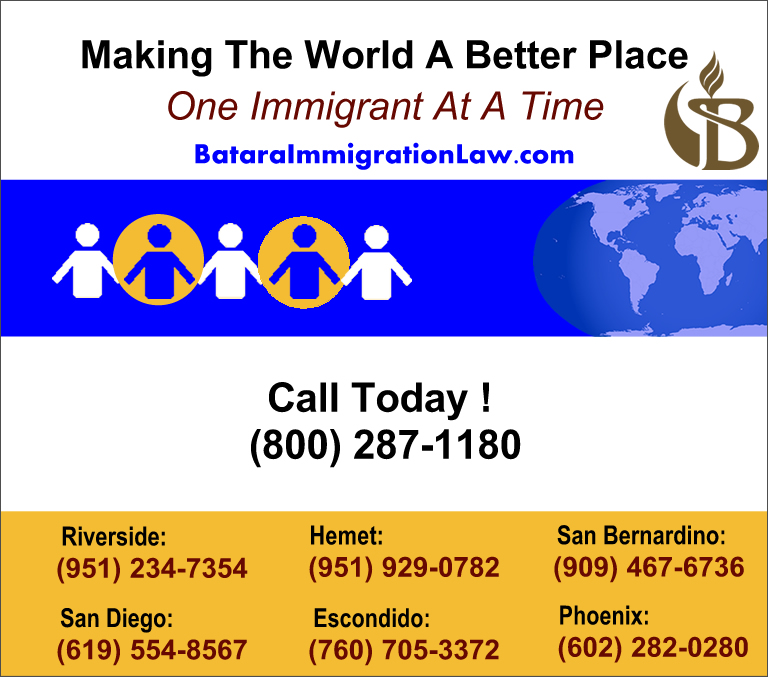This blog post is Part 2 of our Mini-Series On Cancellation Of Removal for non-lawful permanent residents, an important component of our deportation defense services.

In 1996, as part of the Illegal immigration Reform and Immigrant Responsibility Act (IIRAIRA), Congress tightened the hardship formula in deportation court cases involving immigrants lacking legal authority to reside here.
The change, though creating a supposedly more rigorous standard of judicial review, did not eliminate that hardship factors must still be assessed under a totality of the circumstances test.
However, it did affect the permutation of direct and indirect hardship factors necessary for relief from removal.
A Modern Approach To Cancellation Of Removal Hardship Defense
Among the many modifications, as explained in Deportation Defense: Three Spectrums Of Hardship, exceptional and extremely unusual hardship under Cancellation of Removal For Non-LPRs replaced extreme hardship under Suspension of Deportation.
Before IIRAIRA, undocumented immigrants facing deportation could request relief under Suspension of Deportation.
To win, the immigrant had to show that deportation would result in an extreme hardship either to herself or to her spouse, child, or parent who is a U.S. citizen or lawful permanent resident.
After IIRAIRA, an immigrant facing deportation (renamed “removal”) could seek Cancellation of Removal.
Now, an immigrant had to prove that deportation would result in an exceptional and extremely unusual hardship to her spouse, child, or parent who is a U.S. citizen or lawful permanent resident.
This meant that the hardship to be suffered by an immigrant upon deportation was no longer a direct factor of the court’s calculations. At best, such hardship could only be weighed as an indirect factor of misfortune experienced by qualifying relatives.
Direct And Indirect Factors Of Hardship For Qualifying Relatives
At first, it appeared the elimination of an immigrant’s own hardship from a judge’s calculation threw out several aspects of the Anderson formula.
The BIA was quick to highlight this limitation:
“Insofar as some of the factors set forth in Matter of Anderson may relate only to the applicant for relief, they cannot be considered under the cancellation statute, where only hardship to qualifying relatives, and not to the applicant, may be considered. Factors relating to the applicant himself or herself can only be considered insofar as they affect the hardship to a qualifying relative.” (Matter of Monreal.)
Yet, life boundaries are not absolute.
The law may have stripped judges from considering the hardship effects on an immigrant facing deportation from the loss of her community connections, upward employment mobility, and charity work contributions.
However, I’ve witnessed that in most close families, these same factors will have a negative impact on qualifying relatives who stand to lose the love, support, and presence of a mother, father, husband, wife, or child.
This means, if presented properly, immigration judges must nevertheless weigh both direct and indirect hardship factors in nearly all Cancellation of Removal matters.
The You Tube video, shown below, on the hardship of qualifying relatives explores how indirect factors of hardship affecting non-qualifying relatives become, where appropriate, considerations for immigration judges in deciding whether or not to grant relief from deportation.
(And even though such matters are presented differently in other types of immigration deportation relief applications, the exact same types of indirect factors are relevant to immigrants seeking an I-601 waiver, pursuing relief under INA 212(c), 212(h), 212(i), or requesting prosecutorial discretion.)
Thinking About The Unthinkable: A Short Guide To Cancellation Of Removal Hardship Factors
A modern approach to deportation defense, reflected by the Cancellation Of Removal Hardship Factors Wheel shown above, includes presenting direct and indirect hardship evidence such as:
IMMIGRATION HISTORY
- The immigrant’s age, with particular consideration given to minors and the elderly
- The circumstances of immigrant’s arrival in the U.S. and the manner of his or her entry, particularly if the alien came as a young child or to escape discrimination based on religious beliefs, gender, race, ethnicity, age, sexual preference, or to flee from domestic violence, gang warfare, or natural disasters
- The immigrant’s length of residency in the U.S., with consideration given to presence while in lawful status or waiting for permanent resident processing
- The immigrant’s current or future availability of being granted temporary or permanent status or another form of relief from removal, including adjustment of status
COMMUNITY TIES AND CONTRIBUTIONS
- The immigrant’s personal, professional, employment, and volunteer ties, focusing on the degree of integration into society
- The immigrant’s and qualifying relatives’ special assistance and value, including community service, church activity, political involvement, charity work, military, reserves, and volunteerism
- Loss of the qualifying relatives’ personal, school, work, community, and church friends, as well as loss of professional ties
- Whether the immigrant or a qualifying relative is cooperating or has cooperated with federal, state, or local law enforcement authorities
FAMILY TIES HERE AND ABROAD
- The age, number, and immigration status of the immigrant’s spouse, children, and parents
- The presence, relationship, and closeness of extended U.S. citizen and lawful permanent resident family members, including those of qualifying relatives
- Family ties in the country to which the immigrant would be returned and qualifying relatives would be relocated, especially those who have the ability to help the immigrant and qualifying relatives adjust to their lives in a new country
FAMILY RELOCATION OR FAMILY SEPARATION?
Every married immigrant facing deportation has to address a painful issue. Where will his spouse and children live if the judge orders him to return to his home country?
The choice defines trial strategy.
In most cases, the immigrant’s qualifying relatives will leave the U.S. with the immigrant who is deported.
But not always. As a Riverside immigration attorney, I know there are more cases than one might suspect where the qualifying relatives remain in the United States even though the immigrant parent is returned to his home country.
Family Relocation

In the family relocation situations, the key is to present direct and indirect hardship factors that demonstrate how moving to the deported parent’s home country will cause harm to the U.S. citizen or lawful permanent resident spouse and children.
Family Separation

On the other hand, in the family separation situations, the focus of evidence and testimony should be to demonstrate the degree of the qualifying relatives’ loss and suffering in the absence of the deported parent.
And there are hybrid cases.
For example, both parents may be facing deportation. They are from different countries.
Maybe one parent is from Mexico and the other from Guatemala. Perhaps the father was born in Lebanon and the mother in Afghanistan. Or one parent is a citizen of Taiwan and the other is a native of the Philippines.
Sometimes the plan is that, if both parents are deported, all the children will live with one parent. In other cases, the children may be divided among the parents, some living with the mother in one country, some living with the father in a different country.
All of these possibilities will affect how an immigration trial attorney needs to lay out hardship factors to put the client’s best foot forward.
HEALTH AND MEDICAL CONCERNS
- The health, mental, physical, psychological, and medical conditions of the immigrant or the immigrant’s qualifying relatives
- The availability, quality, and costs of necessary medical treatment in the country to which the immigrant would be returned and the qualifying relatives relocated
- Whether the immigrant or qualifying relative is the primary caretaker of an extended U.S. citizen or lawful permanent resident family member or close acquaintance, minor, or elderly person, with a serious health, mental, physical, psychological, mental disability or illness
SOCIOCULTURAL HARDSHIPS
- The ability of qualifying relatives, at work and school, to read, write, and speak in the immigrant’s native language
- The possibility of the qualifying relatives’ psychological trauma, from loss of contact with a familiar environment, and adjusting to a new country, new language, new customs, and new environment
- For qualifying relatives who are lawful permanent residents, loss of valid immigration status, compelled cultural readjustment, and forced residency in country with a lower standard of living upon relocation to immigrant’s home country
THINKING ABOUT THE UNTHINKABLE
It’s not easy to think about hardship factors.
I compare it to writing a will or a trust. Who really wants to talk about dying?
It hurts to think about what will happen if someone you love is deported. And when you hurt so deeply, can you think clearly and deeply about the future hardship?
This is why I suggest using a short guide to help you prepare for your hardship court hearing or agency interview. You do not want to miss any important issues.
However, please note that no guide can be exhaustive and include all potentially favorable direct and indirect hardship factors.
But a guide is a good starting point to begin your quest to win permanent residency under Cancellation of Removal.
CAREER AND EDUCATIONAL DISRUPTION
- The impact of a disruption of employment, career, and professional opportunities for the immigrant and qualifying relatives in the United States, especially those who have graduated from high school or college, or completed substantial training in their chosen profession
- The inability of the immigrant and qualifying relatives to pursue a certain profession in the country to which the immigration would be returned and the qualifying relatives would be relocated
- The loss of the immigrant’s and qualifying relatives’ employability due to inferior economic and business opportunities, including diminished wage levels, age, and gender discrimination
- The availability, quality, and costs of schooling and education opportunities for the immigrant and qualifying relatives, especially minor children, in the country to which the immigrant would be returned and the qualifying relatives relocated
ECONOMIC AND FINANCIAL ISSUES
- The immigrant’s and qualifying relatives’ economic, business, property, and financial ties to the United States
- The immigrant’s and qualifying relatives’ economic, business, property, and financial ties outside the United States
- Financial impact of the immigrant’s departure and loss of job and income on qualifying relatives, as well as on the immigrant’s and qualifying relatives’ extended U.S. citizen and lawful permanent resident family members, especially the elderly, the seriously ill, the young, and the disabled
CONDITIONS IN THE COUNTRY OF DEPORTABILITY
- The current political and economic conditions in the country to which the alien would be returned and the qualifying relatives relocated
- The circumstances under which an immigrant left his or her country and the political consequences of his or her return, including violence and security concerns
- The possibility of religious, gender, race, age, or sexual preference discrimination
A PERSONAL WORD FOR THOSE FACING CANCELLATION OF REMOVAL
Due to a heavy work overload, immigration judges tend to rush cases along. They often become upset when matters do not proceed in their preferred format.
However, it’s your future at stake.
In my view, putting up your best fight against the possibility of forced relocation with or forced separation from your family is too important to sacrifice simply to appease an immigration judge.
A missed hardship factor here, an omitted hardship factor there, eventually adds up, and may lead to the denial of your deportation defense application.
It’s up to you to do nothing less than your best.
It’s up to you to present every relevant hardship factor possible in your defense against deportation.
Do that – and victory may be closer than you ever imagined.
By Carlos Batara, Immigration Law, Policy, And Politics
You can find the other blog posts in our four-part Mini Series On Cancellation of Removal for non-lawful permanent residents here:






